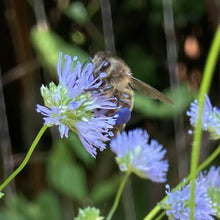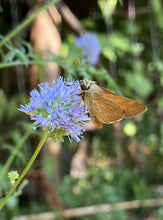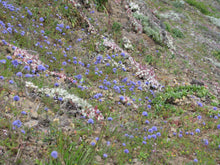Gilia capitata
Blue gilia is an annual wildflower that grows easily from seed and is hands-down one of the most attractive plants for bumblebees, other native bees, and European honeybees. Stand near a patch of this flowering plant in June and you will literally hear the buzz of a diversity of native bees. It's quite tall, reaching up to three feet and forming dense, spherical, blueish-purple flower heads - each flower head containing up to 100 miniscule flowers! As bees collect the blue pollen, their pollen sacs will turn an amazing deep blue/purple color.
- Plant type/canopy layer: deciduous, annual, herbaceous plant
- Size at maturity: 24”-36” tall, 6” wide
- Light requirements: full sun to part shade
- Moisture requirements: dry to moist soil, prefers fast to med drainage
- Bloom time: May - September (June - July in the Portland Metro area)
- Growth rate/ease: fast growing, moderately easy to grow
- Wildlife support: flowers attract and provide nectar to hummingbirds, adult butterflies, bees and other insect pollinators; overall plant attracts and supports beneficial and other pest eating insects and is a caterpillar host plant and larval food source for native moths and butterflies
- Native habitat/range: grows in open, sandy or rocky soils along grassy hillsides, meadows and forest edges and openings, from near sea-level to 2500m in much of western Oregon, California and Washington. Portland Plant List - Yes.
- Special features & uses: hummingbird and pollinator favorite; drought-tolerant; functions well in bouquets and cut floral arrangements; landscape uses include meadowscapes, pollinator gardens, rock gardens and greenroofs
Gardening with Blue Gilia: Sow seed following the instructions below, in relatively open, sunny areas of your yard. It tolerates clay, but prefers faster drainage, and is exceptionally drought-tolerant, thereby adding color and habitat value to the driest areas of your yard. Pollinators are most attracted to large swaths (i.e. more than 6’x6’) of the same color because most native bees, unlike European honey bees, practice floral fidelity, which means they only forage from one species of plant at a time. Consider contrasting Gilia with other pollinator faves like California poppies, native alliums or showy fleabane for a meadowscape that is truly impressive to insects and gardeners alike.
Seed Packet Contains: approximately 500 seeds
When and How to Sow Seeds: Sow blue gilia in the fall or spring. If sowing in the fall, wait until after the rains have returned.
You can 1) generally broadcast approximately 60 seeds/sq ft, 2) start a small pinch in small garden pots or 3) start "in situ" by pinching little bits of it here and there in blank areas of your sunny garden areas. Simply spread the seeds on the surface of the soil and do not cover. They will require little to no cold stratification. They should germinate and grow into tiny sprouts in the fall, then sit tight without any more growth until spring when they take off. If sowing in spring, the earlier the better as cooler temps may enhance germination.
Photo Credits 1 & 2: Tracy Cozine, Sparrowhawk Native Plants
Photo Credit 3: "Gilia capitata tomentosa" by Roger Raiche is licensed under CC BY 4.0.






